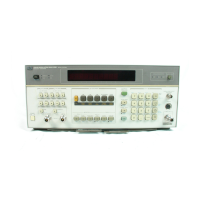54
RF
Frequency and Frequency
Error
Frequency
Offset
Mode
This procedure demonstrates how the
HP
8901Bs
Frequency
Offset Mode allows you to measure input signals above 1300 MHz
using an external oscillator and mixer.
(This
is
one of three
techniques available for extending the
RF
frequency range of
the HP 8901B. The other
two
are
also
shown in this chapter.)
Diagram
5-1
shows the setup for this down-conversion technique.
MIXER
SIGNAL
SOURCE
HP
89018
LOCAL
OSCILLATOR
Diagram
5-1.
Setup for Frequency
Down
Conversion
1.
2.
3.
4.
5.
6.
7.
Set the
signal
source to the desired frequency at an amplitude
of
about
-5
dBm. (The optimum level
will
depend on the mixer
being used; select a level that
will
prevent mixer compression.)
Set the external
LO
to equal the output frequency
of
the
signal source plus
120.53
MHz.
(For instance,
if
the signal source
frequency
was
2.5
GHz,
the
LO
should
be
set to
2620.53
MHz.)
This
positions the HP 8901Bs internal
IF
in the center of a tuning octave.
Set the output level of the external
LO
to
+8
dBm.
Press
the
AUTOMATIC OPERATION
key and then key in
27.3
SPCL,
the external
LO
frequency, and the
MHz
key
on
the
HP
8901B. If
you make a mistake, press the
CLEAR
key and re-enter the keystrokes.
Manually tune the
HP
8901B to the expected frequency of the signal
source by keying
in
the source frequency and then pressing the
MHz
key.
The Manual Tuning Mode
is
always the right choice for this measurement
technique.
Now
select the desired measurement on the
HP
890lB.
If
you are making
RF
Power or Tuned
RF
Level measurements, the calibration factors for
the Sensor Module that you are using need to be stored in the Frequency
Offset cal factor storage table. Refer to
Appendix
B
for the storage procedure.
When you want to exit the Frequency Offset Mode, key
in
27.0
SPCL.
If you wish to re-enter the Frequency Offset Mode and maintain
the same external
LO
frequency set in step
4,
key in
27.1
SPCL.

